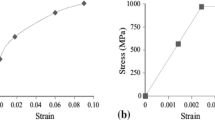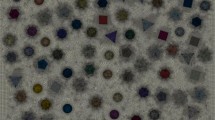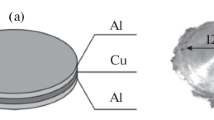Abstract
A study has been made on samples of an extruded metal-matrix composite with an aluminium alloy (2124) matrix reinforced by 17.8% silicon carbide particles. Samples were straightened (plastically stretched) before performing tensile and compact tension tests. Fractographic analysis was affected using SEM analysis on single and matching faces. It was found that the ultimate tensile strength in the transverse direction decreased substantially (∼45 MPa) on stretching and that the fracture toughness was influenced by the quenching rate. Further, the longitudinal and transverse ductilities were found to decrease and increase, respectively, with increasing plastic stretch. The SEM analysis supported a fracture mechanism where particles either fractured or decohered ahead of the crack tip with ductile failure of the matrix between the crack tip and the damaged particles.
Similar content being viewed by others
References
R. DA Silva, D. Caldemaison and T. Bretheau, in “9th RISØ International Symposium on Metallurgy and Materials Science” edited by S. I. Anderson, H. Lilholt and O. B. Pedersen: (RISØ, Roskilde, Denmark, 1988) pp. 333–338.
S. Doong, T. Lee, I. Robertson and H. Birnbaum, Scripta Metall. 23 (1989) 1413.
Y. Flomand R. Arsenault, Mater. Sci. Engng 77 (1986) 191.
B. Roebuck, J. Mater. Sci. Lett. 6 (1987) 1138.
BS 18, 1987 British Standards Institution, “Methods for tensile testing of metals” (1987) (withdrawn), replaced by BS EN 10002: 1990 British Standards Institution, “Tensile testing of metallic materials” (1990).
BS 5447: 1977 British Standards Institution, “Plane strain fracture toughness of metallic materials” (1977).
M. Manoharan, and J. Lewandowski, Acta. Metall. Mater. 38 (1990) 489.
P. Mummery and B. Derby, in “12th RISØ International Symposium on Materials Science” edited by N. Hansen, D. Juul Jensen, T. Leffers, H. Lilholt, T. Lorentzen, A. S. Pedersen, O. B. Pedersen and B. Ralph. (RISØ, Roskilde, 1991) pp. 535–542.
J. Knott, “Fundamentals of fracture mechanics” (Butterworths, London, 1973).
S. Rolfe, and J. Barsom, “Fracture and fatigue Control in Structures” (Prentice-Hall, New York, 1977).
T. Downes, and J. King, in “12th RISØ International Symposium on Materials Science” edited by N. Hansen, D. Juul Jensen, T. Leffers, H. Lilholt, T. Lorentzen, A. S. Pedersen, O. B. Pedersen and B. Ralph. (RISØ, Roskilde, 1991) pp. 305–310.
R. Arsenault and C. Pande, Scripta Metall 18 (1984) 1131.
Y. Flom and R. Arsenault, J. Metals July 38 (1986) 31.
C. Crowe, R. Gray and D. Hasson, 5th International Conference on Composite Materials (AIME, 1985) pp. 843–866.
C. You, A. Thompson and I. Berstein, Scripta Metall 21 (1987) 181.
Author information
Authors and Affiliations
Rights and permissions
About this article
Cite this article
Williams, P., Cannon, S. & Ralph, B. Investigation into fracture mechanisms of, and the effect of stretch-straightening on an extruded metal-matrix composite. Journal of Materials Science 29, 4906–4912 (1994). https://doi.org/10.1007/BF00356542
Received:
Accepted:
Published:
Issue Date:
DOI: https://doi.org/10.1007/BF00356542




